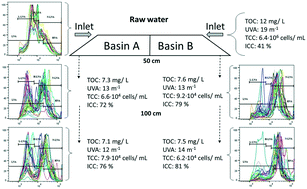Water quality changes during the first meter of managed aquifer recharge†
Abstract
The capacity of an artificial recharge field to alter organic matter and the bacterial flora of surface water was assessed by following changes in bacterial communities and composition of natural organic matter (NOM) over the first meter of infiltration depth. The sampling strategy applied in this study ensured that water samples consisted only of infiltrated water, excluding natural groundwater. Water was sampled at 50 and 100 cm below the surface of an infiltration basin divided into two halves; one side was dried and frozen and one was infiltrating water during the winter period prior to the sampling period. Bacterial cell counts, proportions of intact cells and community fingerprints were determined by flow cytometry, and NOM was characterized using total organic carbon (TOC), UV254 nm-absorbance (UVA) and fluorescence spectroscopy. Around 40% of the NOM was removed after only 50 cm. Protein-like components were reduced to a larger extent (45–50%) than the humic-like components (25%), suggesting removal of mostly biodegradable fractions of NOM. After only 50 cm of infiltration, about 99% total cell count (TCC) was removed. The flow cytometric data revealed that the bacterial communities collected after infiltration from the basin area that had been dried and frozen were more similar to those in the raw water. This suggests that drying and freezing the basin negatively impacted its treatment capacity. The results from this study highlight the importance of a well-developed biofilm and unsaturated zone for artificial recharge.

- This article is part of the themed collection: Recent Open Access Articles


 Please wait while we load your content...
Please wait while we load your content...